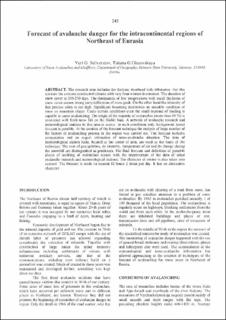Geomorphologic and geobotanical features of slushflows (Khibiny mountains instance)
Chapter
Permanent lenke
https://hdl.handle.net/11250/3082592Utgivelsesdato
1998Metadata
Vis full innførselSamlinger
- NGI articles [1028]
Sammendrag
The research area includes the Kolyma riverhead with tributaries. For this territory the extreme continental climate with very frost winters is common. The duration of snow cover is 200-230 days. The domination of low temperatures with small thickness of snow cover causes strong recrystallization of snow pack. On the other hand the intensity of titis process often is not high. Significant loosening determines an unstable condition of snow on mountain slopes. Under certain conditions even tile small increase of loading is capable to cause avalanching. The origin of tile majority of avalanches (more than 60 %) is connected with fresh snow fall on tile friable base. A network of avalanche research and meteorological stations in tilis area is scarce. In such conditions only background (area) forecast is possible. At the creation of tile forecast technique tile analysis of large number of the factors of avalanching process in the region was carried out. The forecast includes computation and an expert estimation of snow-avalanche situation. The data of meteorological station Kulu, located at the center of area, are used as the basis of the technique. The sum of precipitation, its intensity, temperature of air and its change during the snowfall are distinguished as predictors. The final forecast and definition of possible places of crashing of avalanches occurs with the improvement of the data of other avalanche research and meteorological stations. The character of winter is also taken into account. The forecast is made on nearest 12 hours 2 times per day. It has an altemative character.
